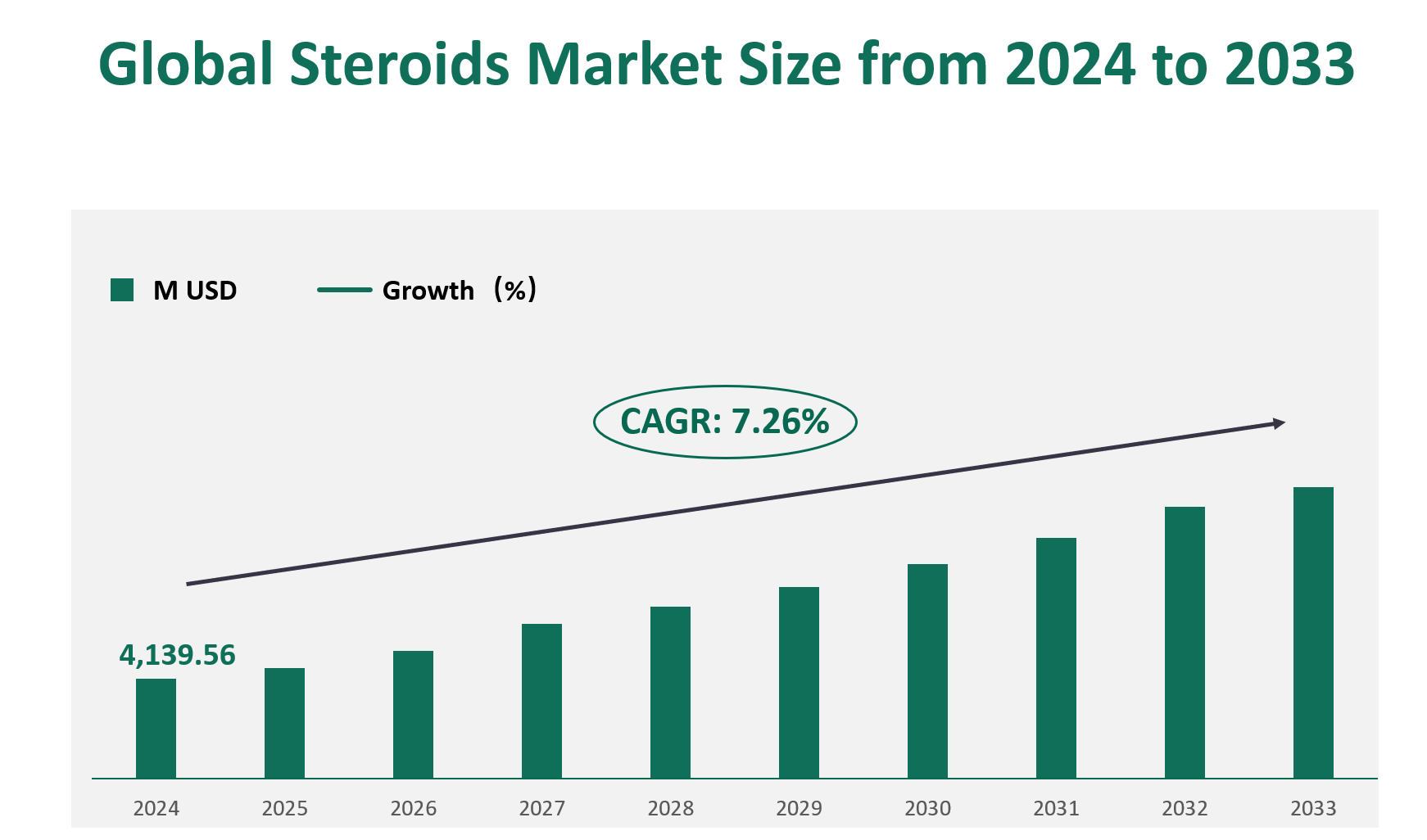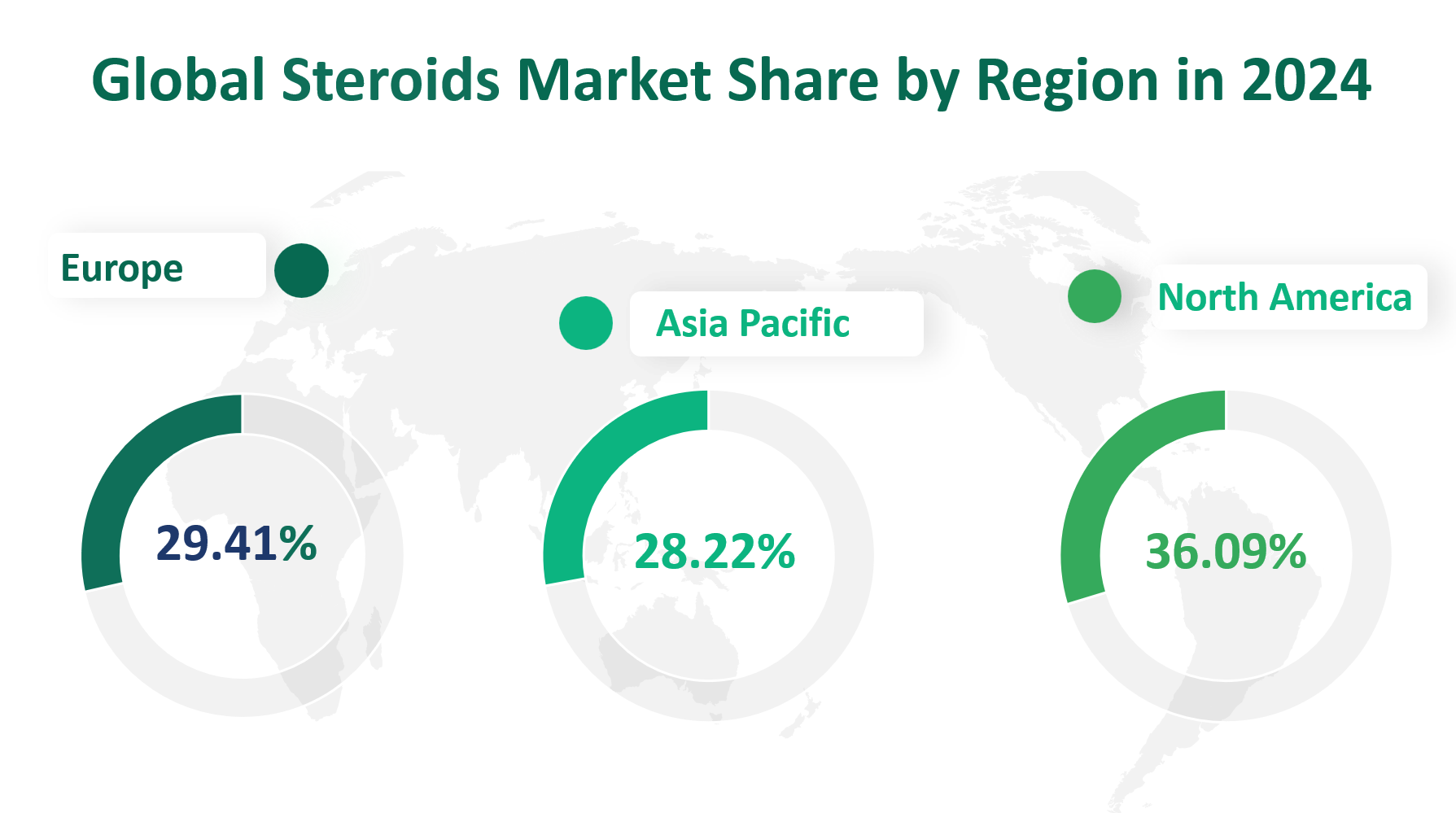1. Global Steroids Market Insight Analysis
In 2024, the Steroids market revenue is projected to reach 4,139.56 million USD. This growth is expected to continue in the coming years, with a Compound Annual Growth Rate (CAGR) of 7.26% from 2024 to 2033.
Steroids are a class of organic compounds that include hormones and other biologically active substances. They are characterized by a specific molecular structure with four fused rings. Medically, steroids are categorized into corticosteroids and sex hormones. Corticosteroids, such as glucocorticoids and mineralocorticoids, play crucial roles in regulating immune responses, reducing inflammation, and managing various chronic conditions like asthma and rheumatoid arthritis. Sex hormones, including progesterone, androgens, and estrogens, are vital for reproductive functions and maintaining hormonal balance in the body.
Figure Global Steroids Market Size (M USD) and CAGR (2024-2033)

2. Driving and Limiting Factors of Steroids Market Growth
The growth of the global Steroids market is influenced by several driving and limiting factors. On the positive side, the booming pharmaceutical industry is a key driver. As the global economy grows and living standards improve, the demand for pharmaceuticals, including steroids, continues to rise. The increasing prevalence of chronic diseases and the aging population further fuel the need for effective treatments, driving the market forward.
Additionally, technological advancements in production processes have improved the efficiency and quality of steroid manufacturing. Automation and intelligent manufacturing technologies have reduced labor costs and increased production capacity, making the industry more profitable and sustainable.
However, the market also faces significant challenges. One major limiting factor is the fluctuation in raw material prices. Key raw materials such as diosgenin, androstenedione, and dienes are essential for steroid production, and their price volatility can impact production costs and profitability. Environmental regulations also pose a challenge. Stringent environmental policies require companies to invest in pollution control measures, increasing operational costs. Non-compliance can lead to penalties and production halts, affecting market performance.
Moreover, the potential side effects of steroid misuse, such as cardiovascular diseases and hormonal imbalances, have led to strict government regulations. This regulatory oversight can limit market expansion and increase compliance costs for manufacturers.
3. Technology Innovation and Corporate Mergers and Acquisitions in Steroids Market
Technological innovation and corporate mergers and acquisitions (M&A) are key dynamics shaping the Steroids market. Advances in production technology have been pivotal in enhancing the industry’s efficiency and output. Companies are increasingly adopting automated and intelligent manufacturing systems to reduce labor costs and improve product quality. For example, Hovione, a leading API manufacturer, has invested $170 million in expanding its facilities and capabilities to meet growing demand. This expansion includes state-of-the-art spray drying and particle engineering technologies, enhancing the company’s production capacity and market competitiveness.
Corporate M&A activities have also played a significant role in consolidating the market and driving growth. Major players are engaging in strategic partnerships and acquisitions to expand their product portfolios and market reach. For instance, Pfizer’s acquisition of Arena Pharmaceuticals for $100 per share in December 2021 demonstrates the industry’s trend towards consolidation. This acquisition not only strengthens Pfizer’s position in the market but also provides access to Arena’s development-stage therapeutic candidates, enhancing Pfizer’s R&D capabilities. Similarly, LEO Pharma’s acquisition of Bayer’s prescription dermatology business in 2019 expanded LEO Pharma’s portfolio in dermatological treatments, leveraging Bayer’s existing market presence.
4. Global Steroids Market Size by Type
The global steroids market is primarily segmented into two major product types: Corticosteroids and Sex Hormones.
Corticosteroids are a class of steroids that include glucocorticoids and mineralocorticoids. They are widely used for their anti-inflammatory, immunosuppressive, and anti-allergic properties. Corticosteroids are essential in treating a range of conditions, from asthma and allergies to autoimmune diseases and certain cancers. Their versatility and effectiveness make them a cornerstone in modern medicine.
Sex Hormones, on the other hand, include progesterone, androgens, and estrogens. These hormones are critical in regulating reproductive functions, secondary sexual characteristics, and maintaining overall hormonal balance in the body. They are used in treatments related to fertility, menopause, and hormonal imbalances.
In terms of revenue, the market for these two product types is projected to reach significant milestones by 2024. Within this market, Corticosteroids are anticipated to account for 3,017.58 million USD, while Sex Hormones are projected to contribute 1,121.98 million USD.
Table Global Steroids Market Size by Type in 2024
|
Market Size (M USD) 2024 |
Market Share | |
|
Corticosteroids |
3017.58 |
72.90% |
|
Hormones Steroids |
1121.98 |
27.10% |
|
Total |
4139.56 |
100.00% |
5. Global Steroids Market Size by Application
The applications of steroid are diverse, spanning multiple medical fields and treatment modalities. The primary applications include Topical, Inhalation, Injection, and Oral formulations.
Topical applications involve the use of steroid directly on the skin or mucous membranes. These formulations are commonly used to treat skin conditions such as eczema, psoriasis, and dermatitis. Topical steroids are also used in ophthalmology and otolaryngology for local anti-inflammatory effects.
Inhalation applications are primarily used in respiratory medicine. Inhalation steroids are crucial in managing conditions like asthma and chronic obstructive pulmonary disease (COPD). They provide targeted anti-inflammatory effects directly to the respiratory tract, reducing symptoms and improving respiratory function.
Injection applications involve the administration of steroid directly into the body, either intravenously or intramuscularly. Injectable steroids are used for systemic anti-inflammatory effects and are often employed in treating severe allergic reactions, autoimmune diseases, and certain types of cancer.
Oral applications involve the ingestion of steroid medications. Oral steroids are used for systemic treatment of various conditions, including rheumatoid arthritis, inflammatory bowel disease, and certain autoimmune disorders. They are also used in hormone replacement therapy and other systemic treatments.
In terms of revenue, the Topical applications are expected to generate 1,440.08 million USD, Inhalation applications are projected to contribute 729.02 million USD, Injection applications are forecasted to bring in 432.20 million USD, and Oral applications are anticipated to account for 1,538.26 million USD.
Table Global Steroids Market Size by Application in 2024
|
Application |
Market Size (M USD) 2024 |
Market Share |
|
Topical |
1440.08 |
34.79% |
|
Inhalation |
729.02 |
17.61% |
|
Injection |
432.20 |
10.44% |
|
Oral |
1538.26 |
37.16% |
6. Global Steroids Market Size by Major Region
North America is expected to remain the largest market by revenue, contributing 1,494.10 million USD in 2024. This region’s dominance is attributed to its robust healthcare infrastructure, high demand for advanced pharmaceuticals, and significant investments in research and development.
Europe follows closely, with an estimated revenue of 1,217.24 million USD in 2024. The European market benefits from strong regulatory frameworks, a well-established pharmaceutical industry, and a high demand for corticosteroids and sex hormones.
The Asia-Pacific region is projected to generate 1,168.12 million USD in 2024, making it the third-largest market by revenue. This region’s growth is fueled by rapid economic development, increasing healthcare awareness, and a growing middle-class population.
South America is expected to contribute 149.99 million USD to the global steroid market in 2024. Brazil and Argentina are the primary markets in this region, with Brazil accounting for the majority of the revenue.
The Middle East and Africa region is projected to generate 110.11 million USD in 2024. This region’s market is driven by increasing healthcare investments, particularly in countries like Turkey and South Africa.
Figure Global Steroids Market Size by Region in 2024

7. Global Steroids Market Analysis by Major Players
7.1 Pfizer
Introduction and Business Overview: Pfizer is a leading multinational pharmaceutical company headquartered in New York City, USA. Established in 1849, Pfizer is one of the largest pharmaceutical companies globally, with a diverse portfolio of products spanning immunology, oncology, cardiology, endocrinology, and neurology. The company is renowned for its innovative research and development capabilities and its commitment to improving global health.
Products Offered: Pfizer offers a wide range of corticosteroids and sex hormones, including Dexamethasone acetate, Dexamethasone sodium phosphate, and various other formulations. These products are used in treating a variety of conditions, from inflammation and autoimmune diseases to endocrine disorders.
Sales Revenue in 2021: Pfizer’s steroid revenue in 2021 was 339.23 million USD.
7.2 Sanofi
Introduction and Business Overview: Sanofi is a French multinational pharmaceutical company headquartered in Paris. Established in 1973, Sanofi operates in the prescription and over-the-counter markets, covering seven main therapeutic areas: cardiovascular, central nervous system, diabetes, internal medicine, oncology, thrombosis, and vaccines. The company is known for its innovative approach to drug development and its commitment to improving patient outcomes.
Products Offered: Sanofi’s steroids portfolio includes Hydrocortisone acetate, Hydrocortisone hemisuccinate, and various other corticosteroids and sex hormones. These products are used in treating inflammatory conditions, autoimmune diseases, and endocrine disorders.
Sales Revenue in 2021: Sanofi’s steroid revenue in 2021 was 280.18 million USD.
7.3 VTR Bio-Tech
Introduction and Business Overview: VTR Bio-Tech is a high-tech company headquartered in Zhuhai, China. Established in 1991, VTR Bio-Tech specializes in the production of steroid hormones, biological enzyme preparations, plant extracts, functional feed additives, and animal drugs. The company leverages advanced technologies such as genetic engineering and biochemical synthesis to develop its products.
Products Offered: VTR Bio-Tech offers a range of corticosteroids and sex hormones, including Dexamethasone. These products are used in various medical applications, from anti-inflammatory treatments to hormone replacement therapies.
Sales Revenue in 2021: VTR Bio-Tech’s steroid revenue in 2021 was 171.18 million USD.

